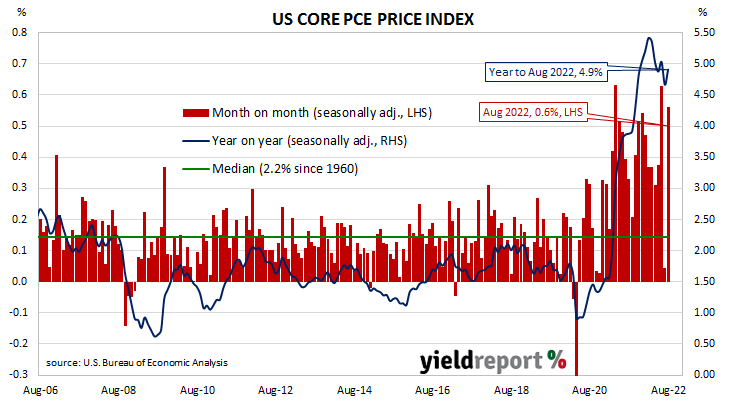Summary: US core PCE price index up 0.6% in August, slightly above expectations; annual rate accelerates from 4.7% to 4.9%; “growing signs” goods inflation pressures easing, slowing earnings growth “key”; Treasury yields down; Fed rate-rise expectations firm.
One of the US Fed’s favoured measures of inflation is the change in the core personal consumption expenditures (PCE) price index. After hitting the Fed’s target at the time of 2.0% in mid-2018, the annual rate then hovered in a range between 1.8% and 2.0% before it eased back to a range between 1.5% and 1.8% through 2019. It then plummeted below 1.0% in April 2020 before rising back to around 1.5% in the September quarter of that year. It has since increased significantly above the Fed’s target.
The latest figures have now been published by the Bureau of Economic Analysis as part of the August personal income and expenditures report. Core PCE prices rose by 0.6% over the month, slightly above expectations but considerably more than July’s flat result after it was revised down from 0.1%. On a 12-month basis, the core PCE inflation rate accelerated from July’s revised figure of 4.7% to 4.9%.
“There are growing signs of easing goods inflation pressures but slowing earnings growth will be key to giving the Fed confidence inflation will fall back to target,” said NAB economist Taylor Nugent.
US Treasury bond yields fell on the day. By the close of business, the 2-year Treasury bond yield had lost 5bps to 4.15%, the 10-year yield had shed 13bps to 3.71% while the 30-year yield finished 12bps lower at 3.66%.
In terms of US Fed policy, expectations of a higher federal funds rate over the next 12 months firmed slightly. At the close of business, November contracts implied an effective federal funds rate of 3.705%, 63bps higher than the current spot rate while December contracts implied a rate of 4.01%. September 2023 futures contracts implied 4.385%, 131bps above the spot rate.
The core version of PCE strips out energy and food components, which are volatile from month to month, in an attempt to identify the prevailing trend. It is not the only measure of inflation used by the Fed; the Fed also tracks the Consumer Price Index (CPI) and the Producer Price Index (PPI) from the Department of Labor. However, it is the one measure which is most often referred to in FOMC minutes.


